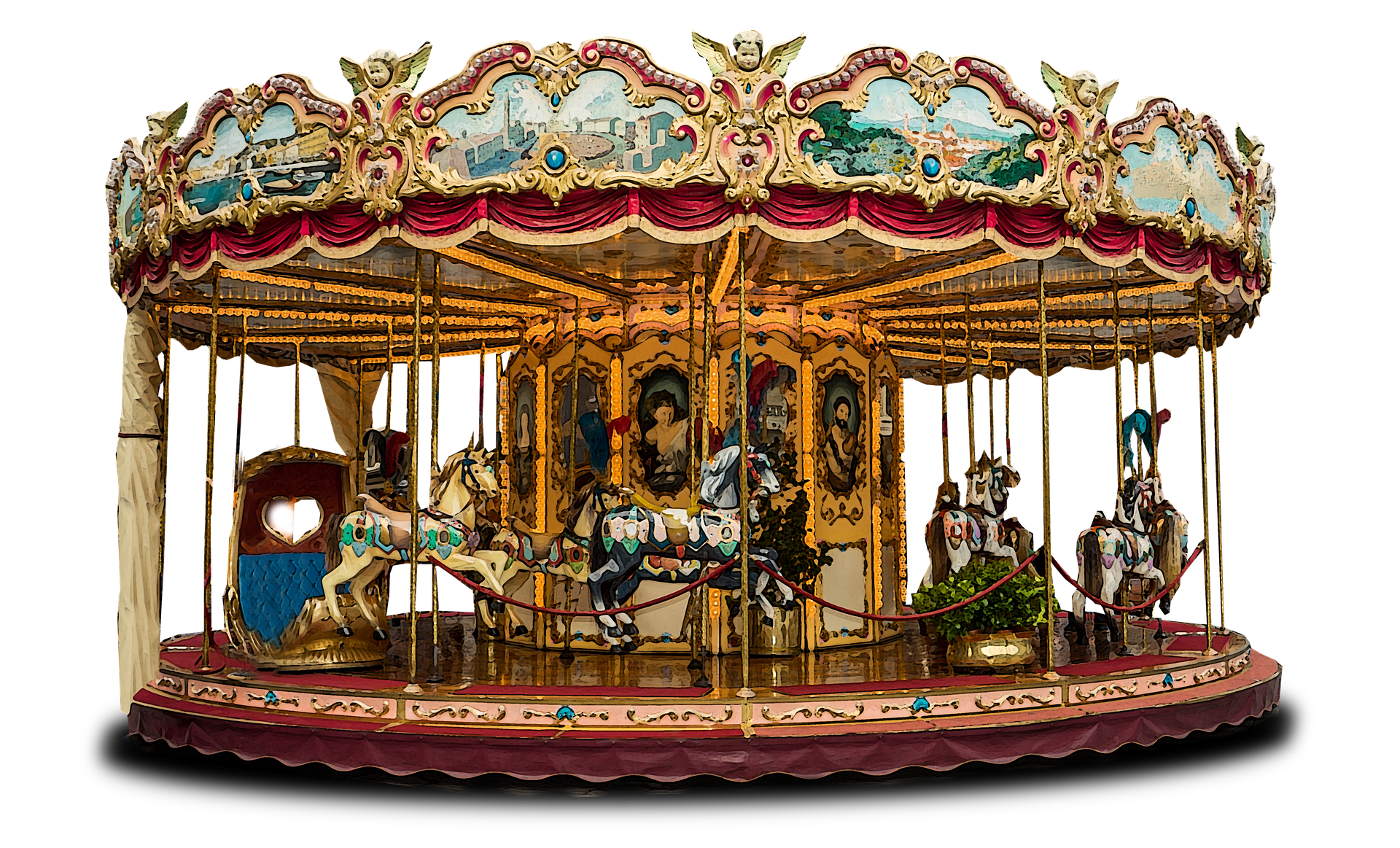The History of Merry-Go-Rounds

The History of Merry-Go-Rounds
Merry-go-rounds might be called a variety of names, including roundabouts and carousels. Whatever the term, merry-go-rounds have been a popular attraction for generations. People of virtually every age can hop aboard a merry-go-round to enjoy a ride, and merry-go-rounds come in many different styles and themes to appeal to just about anyone.
Merry-Go-Rounds in Europe
Crusaders returning back home after fighting adopted a foreign tradition known as "little war." In this "carosella," people rode horses holding lances and tried to spear a ring hanging overhead from a tree limb. In France, this type of tournament was known as a "carrousel." During medieval times, merry-go-rounds were used to train knights. While sitting on wooden planks that were suspended from a center post in a circular shape, the knights tried to thrust their lances through a suspended ring. Merry-go-rounds originated from this old training tradition to become a carnival activity enjoyed by people of all ages.
Merry-Go-Round Evolution
During the 1600s, the carousel was enhanced by French innovation. Now, instead of wooden planks, carved horses were suspended from chains, which were attached to a center post. Noblemen who were training would sit on the horses while they moved up and down around the center post. The idea was to simulate the horse-riding experience without posing the threat of injury to real horses.
Merry-Go-Rounds for Entertainment
Within the next 100 years, the carousel evolved to become smaller. These new contraptions were designed for entertainment instead, and live bands often played music while the merry-go-rounds moved. Some merry-go-rounds were powered by animals, while others were moved by men. Michael Dentzel was a German wagon-maker who would become famous for carving intricate animal figures for merry-go-rounds. These artistic elements caught on during the 1700s in England, France, and Italy. The largest carousel-makers during this time were Bayol in France and Heyn in Germany. Design improvements eventually led to the merry-go-rounds we see today, with platforms that have animals attached to them.
Merry-Go-Rounds in America
America became the home of many European immigrants during the 1800s, and these immigrants brought their love of the carousel with them to America. A Brooklyn business received the first patent for a carousel in 1850, although merry-go-rounds were probably present in the country for several years before this. Charles I.D. Looff is credited with carving and building his first carousel in 1876, which became the first carousel on Coney Island. Looff built more than 45 carousels during his lifetime. As the Industrial Revolution took hold, mass production of the heavy machinery involved with merry-go-rounds became possible, broadening their reach. People also gained extra leisure time thanks to the Industrial Revolution, which they used for relaxation at parks across the country.
Steam-Powered Merry-Go-Rounds
American carousels experienced significant upgrades during the 19th century. Steam power replaced animal power, which enabled merry-go-rounds to be bigger and heavier. This was the beginning of the big, round carousels that are still popular today. Gustav Dentzel set up a sizable carousel in Philadelphia in 1860 that would be the first of many: The Dentzel Carousel Company designed and built two or three carousels each year, selling them to amusement parks. The Dentzel factory built carousels for 60 years, manufacturing units that were consistent in appearance and design.
Electric-Powered Merry-Go-Rounds
Carousels were converted over to electric power by the end of the 19th century. This was also the time when fair organs became a part of the carousels themselves instead of operating beside them. When the 20th century began, a number of companies were manufacturing merry-go-rounds for amusement parks, but amid the Great Depression, many of these companies went out of business. Only one company managed to hang on, known as the Philadelphia Toboggan Company. The Philadelphia Toboggan Company's main source of revenue was manufacturing roller-coasters. If an amusement park ordered a roller-coaster, PTC would often add a merry-go-round to the order free of charge.
PTC employed many wood-carvers, but Daniel Muller was one of the best horse-carvers who worked for the company. Eventually, PTC devised a special jig that enabled them to carve three horses at once. This enabled Muller to carve one horse head, and then the jig would follow the same design to make additional copies of the same carving. As the Great Depression took hold, PTC found itself with extra pre-made carousel parts in stock, and all but one worker was laid off. Several years later, World War II necessitated a focus on the war effort instead of entertainment, so carousels fell by the wayside even more. When the economy rebounded, carousel production improved, and units were made from aluminum and synthetic materials. Only about 150 classic carousels built in the United States are still in existence, many of them preserved by museums.
Who's in the Lead?
While you wouldn't think that a circle of animals would have a front or back, folklore tells us that there is a way to determine the lead horse on a carousel. Typically, the lead horse is the largest and most decorated horse on the merry-go-round. You might recognize the lead horse as a fancy military or war horse. If the merry-go-round has a chariot, the first horse immediately behind the chariot on the outside of the merry-go-round is considered to be the lead horse.
Further Reading
- The Dizzy History of Carousels Begins With Knights
- Ten of the Oldest Carousels in the U.S.
- Carnival Contrivances: A Brief History of the Carousel
- Life's Just a Merry-Go-Round: Exploring Carousel Animals in the Museum's Collection
- Carousels Emerged From Early Jousting Traditions in Europe and the Middle East
- Antique Merry-Go-Rounds Fight Extinction
- Coney Island Historic Carousel List
- The Carousel
- Merry-Go-Rounds
- Merry-Go-Round Climbers
- A Bit of Amusement Ride History
- Philadelphia Toboggan Company Carousel #6
- Playground Physics: Determining the Moment of Inertia of a Merry-Go-Round (PDF)
Written by: Ben Thompson

